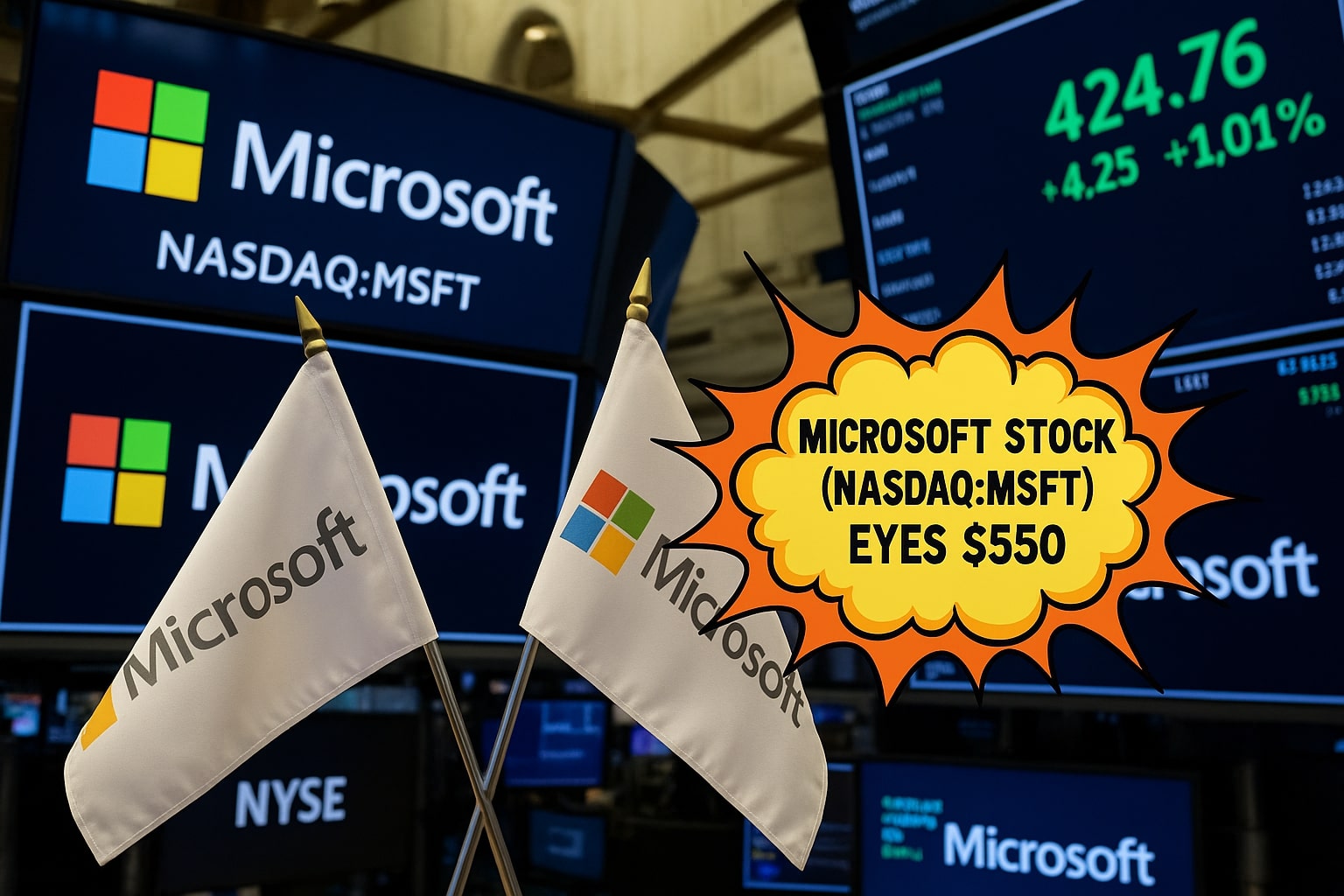
Microsoft Stock (NASDAQ:MSFT) Breaks $490 as AI, Cloud, and Copilot+ Drive Fresh Upside
With $70B in revenue and $3.46 EPS, MSFT’s AI-fueled breakout challenges valuation as split talk and Azure’s 35% growth push shares higher | That's TradingNEWS
Microsoft (NASDAQ:MSFT) Pushes Past $490 As AI Momentum, Cloud Acceleration, and Copilot+ Catalysts Reshape Valuation
AI-Driven Revenues Surge Past $70 Billion With Azure At Center Stage
Microsoft Corporation (NASDAQ:MSFT) delivered another earnings blowout, with total revenue climbing 13% YoY to $70.07 billion and EPS jumping 17.7% to $3.46. The quarter was dominated by strength in Azure, which posted a 35% growth rate in constant currency, and contributed to Microsoft Cloud revenues rising 20% to $42.4 billion. Gross profit grew 11% to $48.15 billion, while operating income surged to $32 billion. The services segment—now Microsoft’s crown jewel—grew 22.3%, offsetting the 10.3% YoY decline in its legacy products division. This ongoing shift in revenue composition is making the stock’s premium P/E multiple of 37.1x more defensible, even as it sits 22.8% above the sector median.
MSFT (NASDAQ:MSFT) Eyes Continued EPS Growth Despite Skepticism Near $500
Trading at $492, MSFT is up 27% since mid-April, far outpacing the S&P 500’s 13.89% return. The stock has tested a 52-week high of $500.76, prompting valuation concerns. Yet with FY2024 revenue at $245.12 billion (+15.6% YoY) and net income hitting $88.14 billion (+22% YoY), the fundamentals support continued gains. On a 10-year horizon, revenue has nearly tripled, up 188.5% (11.18% CAGR). EPS is rising even faster, from $9.72 to $11.86 in just a year, showcasing scalable profitability.
Copilot+ PC and AI-Native Windows Fueling Hardware and OS Refresh Cycle
The Copilot+ PC initiative, integrating Mu-based AI inference locally, represents Microsoft’s most aggressive bet on consumer hardware in years. Though 2024 shipments were modest (800,000 units), 2025 expectations of 5.2 million units signal a potential 500% leap. The October 2025 Windows 10 EOL will force upgrade cycles and fuel demand. Mu’s ability to run natural language queries locally unlocks a defensible advantage in enterprise AI adoption, reducing latency and increasing trust.
On-Device AI (Mu) Unlocks Privacy-First Enterprise Monetization Layer
Microsoft’s AI strategy now extends to local inference. The Mu small language model runs on NPUs from AMD, Intel, and Qualcomm, handling local document summarization and natural voice commands. Microsoft’s Model Context Protocol will turn Mu into a revenue-generating platform by enabling AI plug-ins for local applications, akin to USB peripheral support. While Mu is in early telemetry stages, it strengthens the More Personal Computing (MPC) division, which brought in $13.37 billion in Q3 revenue, +6% YoY. As CapEx hits $21.4 billion (+53% YoY), Mu offers a monetization path to offset depreciation pressure.
Azure's Dominance Amid Cloud Slowdown at Google and Amazon
Azure is outperforming AWS and GCP, which posted 17% and 28% declines, respectively. Azure’s 35% growth is accelerating as Microsoft leverages enterprise trust to expand AI infrastructure within its cloud stack. This growth drove Microsoft Cloud’s revenue to $42.4 billion, which alone would place it among the largest software firms globally. The AI overlay inside Azure—including custom GPT deployments and AI copilots—is reinforcing Microsoft’s multi-layered moat.
Bing AI and Search Advertising Deliver Hidden Upside
Search advertising revenue increased 21% YoY, aided by Bing’s AI integration that favors contextual links over opaque summaries. Microsoft is embedding Bing AI into Office 365 enterprise workflows, which Google cannot match due to its weak business suite penetration. As AI-enhanced enterprise search takes off, Microsoft’s ad revenue per query is rising, suggesting long-term upside for a $20 billion segment over the next three years.
MSFT Dividend Growth Continues But Remains Yield-Light
Microsoft pays a $0.83/share quarterly dividend ($3.32 annually), with a yield of just 0.67%. However, it has raised dividends for 20 consecutive years. It is closing in on Dividend Aristocrat status and still rewards long-term holders.
Will Microsoft Stock Split? Valuation Supports Possibility
With MSFT trading over $490 and a last split dating to 2003, speculation is growing. A 4-for-1 or 10-for-1 split would drop share price into the $40–$125 range, aligning with Apple’s historical behavior. While management has made no statements, historically, $400+ price levels have triggered splits among Dow 30 peers.
Microsoft (NASDAQ:MSFT) Valuation Appears Full But Not Overstretched
With a 20.5x forward EV/EBITDA multiple, markets are pricing in a 16.3% contraction, but EBITDA is forecast to hit $184.1 billion by FY2026. Using a mid-range 21–22x EV/EBITDA, MSFT’s enterprise value projects to $3.96 trillion, implying equity upside to $3.98 trillion—only 7% above current levels. That modest upside is leading some analysts to trim positions.
MSFT Gaming and More Personal Computing Show Flat Trends
Despite the $69B Activision Blizzard acquisition, gaming shows no acceleration. MPC grew 6% YoY in Q3, with Windows OEM and Devices rising just 3%. This raises concerns about diversification outside the AI/cloud juggernaut. Gaming remains a soft spot, with multi-platform releases diluting Xbox’s exclusivity advantage.
Final Verdict: Buy, Hold or Sell NASDAQ:MSFT?
At $492, MSFT remains a Buy for long-term investors seeking enterprise AI and cloud exposure. But near-term gains may stall without a pullback or major split announcement. Investors who entered sub-$400 may consider trimming above $500. Still, no fundamental deterioration has occurred, and Microsoft remains the best-in-class AI play, with its ecosystem growing more defensible by the quarter.
For the real-time chart: MSFT Stock Chart.
That's TradingNEWS
Read More
-
SMH ETF: NASDAQ:SMH Hovering at $350 With AI, NVDA and CHIPS Act Fueling the Next Move
16.12.2025 · TradingNEWS ArchiveStocks
-
XRP ETFs XRPI and XRPR: Can $1B Inflows Lift XRP-USD From $1.93 Back Toward $3.66?
16.12.2025 · TradingNEWS ArchiveCrypto
-
Natural Gas Price Forecast: NG=F Falls to $3.80–$3.94 as Warm Winter Kills $5.50 Spike
16.12.2025 · TradingNEWS ArchiveCommodities
-
USD/JPY Price Forecast - USDJPY=X Slides, BoJ 0.50% Hike, Fed Cut and NFP Set the Next Big Move
16.12.2025 · TradingNEWS ArchiveForex


















